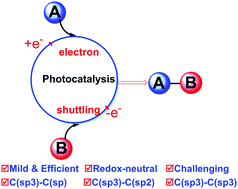当前位置:
X-MOL 学术
›
Chem. Soc. Rev.
›
论文详情
Our official English website, www.x-mol.net, welcomes your
feedback! (Note: you will need to create a separate account there.)
The recent achievements of redox-neutral radical C–C cross-coupling enabled by visible-light
Chemical Society Reviews ( IF 40.4 ) Pub Date : 2017-08-01 00:00:00 , DOI: 10.1039/c7cs00339k Jin Xie 1, 2, 3, 4, 5 , Hongming Jin 6, 7, 8, 9 , A. Stephen K. Hashmi 6, 7, 8, 9, 10
Chemical Society Reviews ( IF 40.4 ) Pub Date : 2017-08-01 00:00:00 , DOI: 10.1039/c7cs00339k Jin Xie 1, 2, 3, 4, 5 , Hongming Jin 6, 7, 8, 9 , A. Stephen K. Hashmi 6, 7, 8, 9, 10
Affiliation

|
Visible-light photoredox catalysis has been esteemed as one sustainable and attractive synthetic tool. In the past four years, a new yet challenging trend, visible-light-driven redox-neutral radical C–C cross-coupling involving putative radical intermediates, has been booming rapidly. Its advent brings a powerful platform to achieve non-classical C–C connections, and should lead to fundamental changes in retrosynthetic analysis. In this tutorial review, we highlight the recent achievements of visible-light-mediated redox-neutral radical C(sp3)–C(sp2), C(sp3)–C(sp), and C(sp3)–C(sp3) bond formation, opening a new window for C–C cross-coupling through the photoredox electron shuttling cycle between two coupling partners. While radical–radical coupling steered by the persistent radical effect was proposed as a rational explanation for the redox-neutral photoredox events, alternative kinetically driven chain propagation and radical addition pathways cannot be ruled out. This tutorial review aims to highlight the recent achievements of photoredox-neutral radical C–C coupling in synthetic chemistry.
中文翻译:

可见光实现的氧化还原中性自由基C–C交叉偶联的最新成就
可见光的光氧化还原催化被认为是一种可持续且有吸引力的合成工具。在过去的四年中,一种新的但具有挑战性的趋势迅速发展,即涉及假定的自由基中间体的可见光驱动的氧化还原-中性自由基C–C交叉偶联。它的出现带来了一个强大的平台,可以实现非经典的C–C连接,并且应该导致逆合成分析的根本变化。在本教程中,我们重点介绍了可见光介导的氧化还原中性自由基C(sp 3)–C(sp 2),C(sp 3)–C(sp)和C(sp 3)–的最新成就。C(sp 3)键的形成,为通过两个偶联配偶体之间的光氧化还原电子穿梭循环进行C–C交叉偶联开辟了新的窗口。尽管有人提出了由持久自由基效应控制的自由基-自由基偶联作为氧化还原-中性光氧化还原事件的合理解释,但不能排除动力学驱动链的替代传播和自由基加成途径。本教程复习旨在强调光氧化还原中性自由基C–C偶联在合成化学中的最新成就。
更新日期:2017-08-29
中文翻译:

可见光实现的氧化还原中性自由基C–C交叉偶联的最新成就
可见光的光氧化还原催化被认为是一种可持续且有吸引力的合成工具。在过去的四年中,一种新的但具有挑战性的趋势迅速发展,即涉及假定的自由基中间体的可见光驱动的氧化还原-中性自由基C–C交叉偶联。它的出现带来了一个强大的平台,可以实现非经典的C–C连接,并且应该导致逆合成分析的根本变化。在本教程中,我们重点介绍了可见光介导的氧化还原中性自由基C(sp 3)–C(sp 2),C(sp 3)–C(sp)和C(sp 3)–的最新成就。C(sp 3)键的形成,为通过两个偶联配偶体之间的光氧化还原电子穿梭循环进行C–C交叉偶联开辟了新的窗口。尽管有人提出了由持久自由基效应控制的自由基-自由基偶联作为氧化还原-中性光氧化还原事件的合理解释,但不能排除动力学驱动链的替代传播和自由基加成途径。本教程复习旨在强调光氧化还原中性自由基C–C偶联在合成化学中的最新成就。











































 京公网安备 11010802027423号
京公网安备 11010802027423号